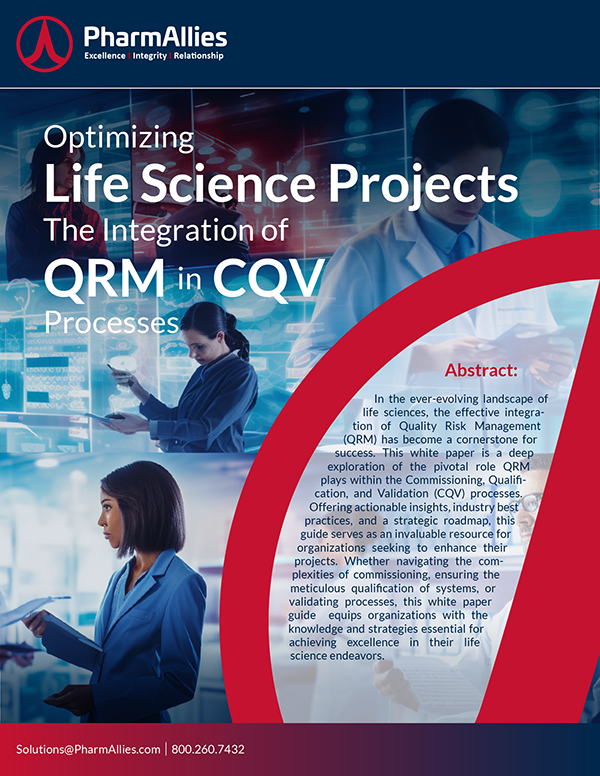10 Steps to Implementing Quality Risk Management (QRM) in Commissioning, Qualification, and Validation (CQV) Projects – QuickNotes
In the dynamic world of life sciences, characterized by rigorous standards, constant evolution, and the relentless pursuit of excellence, the integration of Quality Risk Management (QRM) emerges as a pivotal determining factor of success. Navigating the intricacies of Commissioning, Qualification, and Validation (CQV) processes requires understanding and skillful application of QRM principles. Beyond a mere compliance requirement, QRM becomes a strategic imperative that shapes decision-making, resource allocation, and the overall trajectory of a project.
Embarking on the journey of integrating Quality Risk Management (QRM) into life science projects, particularly in the realm of Commissioning, Qualification, and Validation (CQV), is a crucial strategic move. This summary guide provides encouragement and actionable steps for organizations aiming to initiate or enhance their QRM practices within the context of CQV.
Commit to a Culture of Risk Management Excellence
Organizations should commit to fostering a culture where risk management is not just a process but an integral part of decision-making at all levels. This commitment begins with leadership emphasizing the importance of risk management in achieving project goals. In the context of CQV, aligning risk management with project goals ensures its pivotal role in achieving successful commissioning, qualification, and validation outcomes.
Invest in Comprehensive QRM Training
Recognize the value of investing in comprehensive QRM training for the CQV teams. Equip team members with the knowledge and skills needed to understand, assess, and mitigate risks effectively. Training programs should align with the specific commissioning, qualification, and validation processes, ensuring a robust and compliant approach.
Establish Cross-Functional QRM Teams
Form cross-functional teams dedicated to QRM. Encourage collaboration among representatives from different project phases, including commissioning, qualification and validation, business and technical owners, quality unit, and other relevant departments. This approach ensures a holistic and well-rounded perspective on risk management.
Integrate QRM into Project Planning
Make QRM an integral part of CQV project planning from the outset. Ensure that risk identification, assessment, and mitigation strategies are included in project plans and timelines. This proactive approach allows teams to address potential risks before they impact Commissioning, Qualification, and Validation project milestones.
Utilize Technology for Risk Management
Explore and implement technology solutions that facilitate efficient risk management. Software tools can streamline the identification, assessment, and documentation of risks. Leveraging technology enhances accuracy and provides real-time insights into risks associated with commissioning, qualification, and validation activities.
Implement Regular Risk Review Meetings
Establish regular risk review meetings tailored explicitly for the CQV projects. These meetings should involve cross-functional teams discussing ongoing risks, assessing the effectiveness of mitigation strategies, and adapting plans based on evolving commissioning, qualification, and validation project dynamics. Regular reviews ensure that risk management remains dynamic and responsive.
Encourage Proactive Reporting
Cultivate a proactive reporting culture for CQV teams where team members feel empowered to report potential risks promptly. Implement reporting mechanisms that allow for the timely identification and resolution of issues. Proactive reporting is essential for preventing risks from escalating during commissioning, qualification, and validation activities.
Document and Share Lessons Learned
Document lessons learned from each phase of the CQV process and share these insights across the organization. Creating a repository of lessons learned ensures that future CQV projects benefit from the experiences and knowledge gained. Continuous improvement relies on applying insights from past projects.
QRM integration establishes a feedback loop for continuous improvement in the validation processes. Lessons learned from validation activities, especially those related to risk management, are systematically captured. This information feeds back into the QRM framework, contributing to the refinement and enhancement of risk management strategies for future validation projects.
Engage Stakeholders in QRM Processes
Engage stakeholders, including clients, regulatory bodies, and other relevant parties, in the QRM processes specific to commissioning, qualification, and validation. Solicit their input and insights, ensuring that the risk management approach aligns with broader CQV project goals and industry expectations.
Celebrate Successes and Learn from Challenges
Celebrate successes in effective risk management throughout commissioning, qualification, and validation, and learn from challenges. Recognize and reward teams for their contributions to successful risk identification and mitigation. Use challenges as opportunities for improvement, reinforcing a commitment to continuous enhancement.
Implementing QRM in Commissioning, Qualification, and Validation projects is not just a regulatory requirement; it’s a strategic imperative for ensuring the success of commissioning, qualification, and validation projects. By embracing these steps, organizations can create a culture of excellence, collaboration, and adaptability, ultimately enhancing the overall quality and compliance of their CQV projects.
Download and Read the White Paper
Download this White Paper to unlock success in your life science projects by integrating Quality Risk Management (QRM) into Commissioning, Qualification, and Validation (CQV) processes. Discover actionable steps for robust project outcomes and embrace a culture of risk excellence. Learn how PharmAllies can help you achieve your quality and risk management goals today.
Download HERE

Unlock success in Commissioning, Qualification, and Validation (CQV) projects with our guide. Discover 10 strategic steps for effective Quality Risk Management (QRM).


